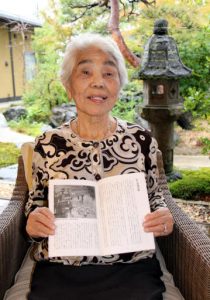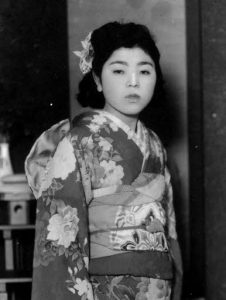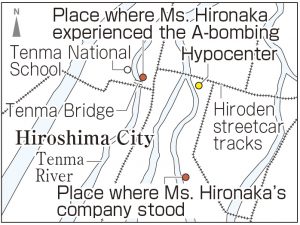Survivors’ Stories: Mitsue Hironaka, 92, Iwakuni: My friend died of Leukemia, and so will I
Dec. 2, 2019
by Kyoko Niiyama, Staff Writer
Mitsue Hironaka (née Matsuo), 92, lost a precious friend of hers shortly after the atomic bomb was dropped on Hiroshima. She and her friend experienced the atomic bombing at the same place, fled together, and they would have been spared. However, radiation had frightful effects on her friend’s body. Ms. Hironaka thought she would die someday, too. She spent days worrying that radiation would adversely affect her body in the same way.
Ms. Hironaka’s parents died of disease in her childhood, and an aunt raised her after the age of twelve. In 1945, she was 18 years old, and doing clerical work at a fish processing company, located in Otemachi (now part of Naka Ward).
On August 6, she was staying at a relative’s home in Nakahiro-machi (now part of Nishi Ward) having taken the day off from work. Around 7:00 a.m. she left for Enomachi (now part of Naka Ward) to see her friend, Tsuyako.
Ms. Hironaka and Tsuyako sat on the external corridor of the shop owned by Tsuyako’s parents and were enjoying talking with each other, looking at the inside garden. Then, the sky suddenly flashed, and she saw a yellow flash. The roof of the two-story wooden shop fell down upon them.
Their location was about 800 meters from the hypocenter. Initially, they were unable to move, blocked by thick pillars and walls. Ms. Hironaka said, “Tsuyako, are you OK?” They made sure they were both all right and managed to crawl out from under the debris by turning around their bodies many times. When Ms. Hironaka looked around, the building was demolished. It was eerily quiet.
Their clothes were tattered, but both escaped injury. When they went to Tenma Bridge, they saw many injured people; their burns so dreadful they wanted to avert their eyes. Looking back on that time, Ms. Hironaka said, “I couldn’t do anything but to encourage them in my mind.”
At Tenma National School (now Tenma Elementary School), Ms. Hironaka and Tsuyako were suddenly spoken to by a girl. She said, “Please take me with you.” When they turned around, they saw a girl standing there, her burnt ear dangling from her head, wearing only underpants. She said she was a sixth grader of a national school. Feeling sorry for her, Ms. Hironaka put her air-raid hood on the girl’s head and the three fled together. They happened to encounter the girl’s family while fleeing.
Ms. Hironaka and Tsuyako later took a military truck to the Hatsukaichi region where Ms. Hironaka parted from Tsuyako and went to a relative’s house in the Rakurakuen region (now part of Saeki Ward).
Three days later, she returned to the central part of Hiroshima. At the riverbank nearby, soldiers were laying scores of dead bodies whose faces and hands were swollen. Soon after that, she suffered from a high fever and diarrhea and was bedridden until the beginning of September. She remembered the stench of bodies being burned, and food would not go down her throat. Her hair fell out, and her gums bled.
At the end of December, Tsuyako’s mother visited Ms. Hironaka and said to her, “My daughter died of leukemia.” According to her, Tsuyako had been well for several months, but suddenly fell ill and passed away before she could receive medical treatment.
Ms. Hironaka later managed to return to work, but often felt sick because of anemia. She married at the age of 20, and she and her husband established themselves as manufacturers of tsukudani, (preservable food boiled down in soy sauce), in the City of Iwakuni. She raised three daughters, and continued to help in the family business.
She has had few opportunities to share her account of the atomic bombing with others. However, she had the idea of saving her experience at least, and in 2009, she spoke of her A-bomb experience in a video recorded by the Hiroshima National Peace Memorial Hall for the Atomic Bomb Victims, located in Naka Ward. She had also shared her account with the A-bomb survivors’ group in Iwakuni.
Whenever she sees her daughters and grandchildren doing fine, she is reminded that precious family members should never have such a terrible experience. She hopes people in nuclear weapon states will have the same feeling as soon as possible.
Teenagers’ Impressions
I felt her strong will in her facial expression
< Ms. Hironaka experienced the atomic bombing near the hypocenter and continued feeling anxious about her disease. She shared her A-bomb experience with us and looked so vigorous it was hard to believe she was 92 years old. I felt her strong will in her facial expression when she said, “I have been strong to convey my experience to you.” As a member of this younger generation, I’m going to convey not only A-bomb experiences but also A-bomb survivors’ thoughts to relay what they have experienced. (Tokitsuna Kawagishi, 18)
I want to convey A-bomb experience to future generations
Ms. Hironaka told us about the time she heard her best friend Tsuyako had passed away. She said to us, “Many people around me had passed away, so I didn’t think it was surprising.” From her words, I can feel the true horror of the atomic bombing. I thought it necessary to convey what Ms. Hironaka and other survivors had experienced to future generations so an atomic bomb would never be dropped again. (Yuno Nakashima, 13)
(Originally published on December 2, 2019)
Mitsue Hironaka (née Matsuo), 92, lost a precious friend of hers shortly after the atomic bomb was dropped on Hiroshima. She and her friend experienced the atomic bombing at the same place, fled together, and they would have been spared. However, radiation had frightful effects on her friend’s body. Ms. Hironaka thought she would die someday, too. She spent days worrying that radiation would adversely affect her body in the same way.
Ms. Hironaka’s parents died of disease in her childhood, and an aunt raised her after the age of twelve. In 1945, she was 18 years old, and doing clerical work at a fish processing company, located in Otemachi (now part of Naka Ward).
On August 6, she was staying at a relative’s home in Nakahiro-machi (now part of Nishi Ward) having taken the day off from work. Around 7:00 a.m. she left for Enomachi (now part of Naka Ward) to see her friend, Tsuyako.
Ms. Hironaka and Tsuyako sat on the external corridor of the shop owned by Tsuyako’s parents and were enjoying talking with each other, looking at the inside garden. Then, the sky suddenly flashed, and she saw a yellow flash. The roof of the two-story wooden shop fell down upon them.
Their location was about 800 meters from the hypocenter. Initially, they were unable to move, blocked by thick pillars and walls. Ms. Hironaka said, “Tsuyako, are you OK?” They made sure they were both all right and managed to crawl out from under the debris by turning around their bodies many times. When Ms. Hironaka looked around, the building was demolished. It was eerily quiet.
Their clothes were tattered, but both escaped injury. When they went to Tenma Bridge, they saw many injured people; their burns so dreadful they wanted to avert their eyes. Looking back on that time, Ms. Hironaka said, “I couldn’t do anything but to encourage them in my mind.”
At Tenma National School (now Tenma Elementary School), Ms. Hironaka and Tsuyako were suddenly spoken to by a girl. She said, “Please take me with you.” When they turned around, they saw a girl standing there, her burnt ear dangling from her head, wearing only underpants. She said she was a sixth grader of a national school. Feeling sorry for her, Ms. Hironaka put her air-raid hood on the girl’s head and the three fled together. They happened to encounter the girl’s family while fleeing.
Ms. Hironaka and Tsuyako later took a military truck to the Hatsukaichi region where Ms. Hironaka parted from Tsuyako and went to a relative’s house in the Rakurakuen region (now part of Saeki Ward).
Three days later, she returned to the central part of Hiroshima. At the riverbank nearby, soldiers were laying scores of dead bodies whose faces and hands were swollen. Soon after that, she suffered from a high fever and diarrhea and was bedridden until the beginning of September. She remembered the stench of bodies being burned, and food would not go down her throat. Her hair fell out, and her gums bled.
At the end of December, Tsuyako’s mother visited Ms. Hironaka and said to her, “My daughter died of leukemia.” According to her, Tsuyako had been well for several months, but suddenly fell ill and passed away before she could receive medical treatment.
Ms. Hironaka later managed to return to work, but often felt sick because of anemia. She married at the age of 20, and she and her husband established themselves as manufacturers of tsukudani, (preservable food boiled down in soy sauce), in the City of Iwakuni. She raised three daughters, and continued to help in the family business.
She has had few opportunities to share her account of the atomic bombing with others. However, she had the idea of saving her experience at least, and in 2009, she spoke of her A-bomb experience in a video recorded by the Hiroshima National Peace Memorial Hall for the Atomic Bomb Victims, located in Naka Ward. She had also shared her account with the A-bomb survivors’ group in Iwakuni.
Whenever she sees her daughters and grandchildren doing fine, she is reminded that precious family members should never have such a terrible experience. She hopes people in nuclear weapon states will have the same feeling as soon as possible.
Teenagers’ Impressions
I felt her strong will in her facial expression
< Ms. Hironaka experienced the atomic bombing near the hypocenter and continued feeling anxious about her disease. She shared her A-bomb experience with us and looked so vigorous it was hard to believe she was 92 years old. I felt her strong will in her facial expression when she said, “I have been strong to convey my experience to you.” As a member of this younger generation, I’m going to convey not only A-bomb experiences but also A-bomb survivors’ thoughts to relay what they have experienced. (Tokitsuna Kawagishi, 18)
I want to convey A-bomb experience to future generations
Ms. Hironaka told us about the time she heard her best friend Tsuyako had passed away. She said to us, “Many people around me had passed away, so I didn’t think it was surprising.” From her words, I can feel the true horror of the atomic bombing. I thought it necessary to convey what Ms. Hironaka and other survivors had experienced to future generations so an atomic bomb would never be dropped again. (Yuno Nakashima, 13)
(Originally published on December 2, 2019)










